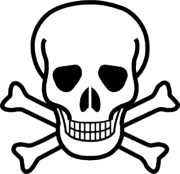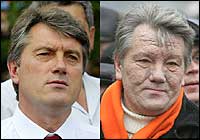Poison
|
|
- This article is about the dangerous substance. For the band see Poison.

In the context of biology, poisons are substances that cause injury, illness, or death to organisms, usually by chemical reaction or other activity on the molecular scale. Some poisons are also toxins, usually referring to naturally produced substances that kill rapidly in small quantities, such as the bacterial proteins that cause tetanus and botulism. A distinction between the two terms is not always observed, even among scientists. Animal toxins that are delivered subcutaneously (e.g. by sting or bite) are also called venom. In normal usage, a poisonous organism is one that is harmful to consume, but a venomous organism uses poison to defend itself while still alive. A single organism can be both venomous and poisonous.The derivative forms "toxic" and "poisonous" are synonymous. Within chemistry and physics, a poison is a substance that obstructs or inhibits a reaction, for example by binding to a catalyst. Poisons have been known to be symbolized by the skull and crossbones (shown beside), although since this attracts children (being linked to pirates) it is gradually being replaced by Mr. Yuk in the United States.
| Contents |
Biological poisoning
Contact or absorption of poisons can cause rapid death or impairment. Agents that act on the nervous system can paralyze in seconds or less, and include both biologically derived neurotoxins and so-called nerve gases, which may be synthesized for warfare or industry. Inhaled or ingested cyanide almost instantly starves the body of energy by poisoning mitochondria and the synthesis of ATP. Intravenous injection of an unnaturally high concentration of potassium chloride, such as in the execution of prisoners in parts of the United States, quickly stops the heart by eliminating the cell potential necessary for muscle contraction. Such rapid reactions are often called acute poisoning.
Most (but not all) pesticides are created to act as poisons to target organisms, although acute or less observable chronic poisoning can also occur to non-target organism, including the humans who apply the pesticides and other beneficial organisms.
A poison may also act slowly. This is known as chronic poisoning and is most common for poisons that bioaccumulate. Examples of these types of poisons are mercury and lead.
Many substances regarded as poisons are toxic only indirectly. An example is "wood alcohol" or methanol, which is not poisonous itself, but is chemically converted to toxic formaldehyde in the liver. Many drug molecules are made toxic in the liver, and the genetic variability of certain liver enzymes makes the toxicity of many compounds differ between one individual and the next.
The study of the symptoms, mechanisms, treatment and diagnosis of biological poisoning is known as toxicology.
Exposure to radioactive substances can produce radiation poisoning, an unrelated phenomenon.
Classification of biological poisons by mechanism
Corrosives
Corrosives mechanically damage biological systems on contact. Both the sensation and injury caused by contact with a corrosive resembles a burn injury.
Acids
Strong inorganic acids, such as concentrated sulfuric acid, nitric acid or hydrochloric acid, destroy any biological tissue with which they come in contact within seconds.
Bases
Strong inorganic bases, such as lye, gradually dissolve skin on contact but can cause serious damage to eyes or mucous membranes much more rapidly. Ammonia is a far weaker base than lye, but has the distinction of being a gas and thus may more easily come into contact with the sensitive mucous membranes of the respiratory system. Quicklime, which has household uses, is a particularly common cause of poisoning. Some of the light metals, if handled carelessly, can not only cause thermal burns, but also produce very strongly basic solutions in sweat.
Oxidizers
Poisons of this class are generally not very harmful to higher life forms such as humans, but lethal to microorganisms such as bacteria. Typical examples are ozone and chlorine, either of which is added nearly every municipal water supply in order to kill any harmful microorganisms present. All halogens are strong oxidizing agents, fluorine being the strongest of all.
- See also: Free radical
Reducing agents
The most notable substance in this class is phosphorus.
Metabolic poisons (energy)
Metabolic poisons act by adversely disrupting the normal metabolism of an organism.
Specific biochemical inhibitors
- By far the most notable substance in this class is carbon monoxide, which blocks the ability of red blood cells to transport oxygen.
- Fluoroacetate blocks a vital step in the citric acid cycle.
- Cyanide bonds with an enzyme involved in ATP production.
- Rotenone - disrupts electron transport in cellular respiration
- Antimycin - disrupts electron transport in cellular respiration
- Malonate - inhibits cellular respiration
- 2,4-Dinitrophenol - disrupts cellular proton gradient
Heavy metals
A common trait shared by heavy metals is the chronic nature of their toxicity. Low levels of heavy metal salts ingested over time accumulate in the body until toxic levels are reached.
Heavy metals are generally far more toxic when ingested in the form of soluble salts than in elemental form. For example, metallic mercury passes through the human digestive tract without interaction and is commonly used in dental fillings—even though mercury salts and inhaled mercury vapor are highly toxic.
Notable examples:
- beryllium (a highly but subtly toxic light metal)
Neurotoxins
Neurotoxins interfere with nervous system functions and often lead to near-instant paralysis followed by rapid death. They include most spider and snake venoms, as well as many modern chemical weapons. One class of toxins of interest to neurochemical researchers are the various cone snail toxins known as conotoxins.
Anticholinesterases
Acetylcholine antagonists
Cell membrane disrupters
Others
- Nicotine - not strictly a neurotoxin, but capable in large doses of causing heart attack
Teratogens (birth defects)
Mutagens (DNA damage)
- Ultraviolet Rays - Long term exposure may cause skin cancer such as Melanoma
- ethidium bromide
Carcinogens (cancer)
A carcinogen is a chemical substance which is believed to cause cancer. There are an enormous variety of possible carcinogens. Some of the better known or more controversial examples are listed below.
- Some artificial sweeteners (e.g. Aspartame and Saccharin) have been alleged to be carcinogenic or neurotoxic (however these research behind these claims is highly controversial and inconclusive; the FDA believes aspartame is safe for humans in dietary doses).
- Asbestos - a widely used insulating material that causes mesothelioma and other cancers especially in the respiratory tract.
- Benzene (lab solvent, used in various chemical reactions).
- Carbon tetrachloride (formerly used in fire extinguishers).
- Dioxin - actually a group of many chemicals - has carcinogenic and other toxic effects.
Examples of biological poisons by source
- Unfinished task: Items below should be added as examples under the appropriate poison class above.
Non-radioactive inorganic poisons
- Arsenic compounds
- inorganic compounds
- Acids and bases, corrosives
- various light metal oxides, hydroxides, superoxides
- Bleach, some pool chemicals, other hypochlorates (acidic and oxydizing effect)
- hydrofluoric acid
Organic poisons
Naturally produced poisons and toxins
- Microorganisms
- ethanol
- botulin toxin
- Tetrodotoxin
- domoic acid (or Amnesic Shellfish Poison, ASP)
- Shellfish toxins (PSP, DSP, NSP, ASP )
- snake and spider venoms
- plant toxins (including many alkaloids)
- strychnine
- solanine
- atropine
- hyoscyamine
- aconite
- curare
- digitoxin
- digoxin
- poison hemlock
- hemlock water dropwort
- Phytohaemagglutinin (Red kidney bean poisoning)
- Grayanotoxin (Honey intoxication)
- fungal toxins
- amanita toxin, see Amanita phalloides
- muscarine
- aflatoxins
- Ciguatera poisoning
- Scombroid poisoning
- Ouabain
- Pyrrolizidine alkaloids
Famous poisonings
See also victims of poisoning
Confirmed poisonings
- Bhopal Disaster — An accidental release of poisonous gas from a pesticide plant in India that killed over 2,000 people and injured many more.
- Jonestown inhabitants — died from a poisoned drink in a mass suicide/murder: see Jonestown mass suicide
- Love Canal — Buried toxic waste was covered and used as a building site for housing and school in Niagara Falls, New York, resulting in claims of chronic poisoning and a massive environmental cleanup.
- Clare Boothe Luce — Fell ill but did not die; arsenic poisoning
- Georgi Markov — Assassinated in London with ricin
- Socrates — According to Plato, killed by drinking Hemlock (water hemlock, not hemlock the evergreen tree)
- Alan Turing — Apparently committed suicide by painting an apple with Cyanide and taking a bite.
- Viktor Yushchenko — poisoned with dioxin during the Ukrainan elections.
Suspected or rumoured poisonings
- Yasser Arafat — Arafat reputedly died from liver cirrhosis, which may be a consequence of chronic alcohol use or poisoning. Some Arafat supporters feel it is extremely unlikely that Arafat habitually used alcohol (forbidden by Islam), and so suspect poisoning, possibly by the Mossad. (Note that cirrhosis is not necessarily caused by alcohol use, or indeed any poison.)
- Napoleon Bonaparte — some claim he was killed by someone on his staff with arsenic. Evidence is inconclusive.
- Charles Darwin — possibly died due to self-medication with Fowler's solution, one percent potassium arsenite
- Jamestown colonists — Standard historical accounts claim deaths by starvation, but the possibility of arsenic poisoning by rat poison (or of death by Bubonic plague) has also been reported (see here (http://www.pbs.org/wnet/secrets2/case3_clues.html))
- Joseph Stalin — Officially cerebral hemorrhage; homewer, according to Vyacheslav Molotov's memoirs, Lavrenty Beria claimed to have poisoned Stalin.
Poisons in crime fiction
This list is incomplete, given that poisoning is a frequent plot twist in crime fiction.
Novels
- Anthony Berkeley: The Poisoned Chocolates Case
- John Dickson Carr: The Burning Court
- Agatha Christie: Three Act Tragedy
- Agatha Christie: A Pocket Full of Rye
- Agatha Christie: Crooked House
- Agatha Christie: And Then There Were None
- Freeman Wills Crofts: The 12.30 from Croydon
- Ann Granger: Say It With Poison
- Francis Iles: Before the Fact (filmed as Suspicion)
- Francis Iles: Malice Aforethought
- Raymond Postgate: Verdict of Twelve
- Dorothy Sayers: The Unpleasantness at the Bellona Club
- Dorothy Sayers: Strong Poison
- Cornell Woolrich: Waltz into Darkness (filmed as Mississippi Mermaid and Original Sin)
Plays
Films
See also
- Antidote
- Biosecurity
- Food poisoning
- Food taster
- LD50
- Lead poisoning
- Lethal injection
- List of poisonings
- Mithridates VI of Pontus
- Pesticide poisoning
- Pollutant
- Toxicity
- Venom
da:Gift de:Gift eo:Veneno es:Veneno et:Mürk fr:Poison he:רעל ja:毒 la:Venenum lt:Nuodas nn:Gift pl:Trucizna pt:Veneno simple:Poison fi:Myrkky sv:Gift

